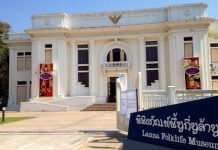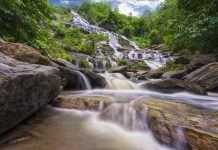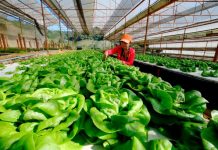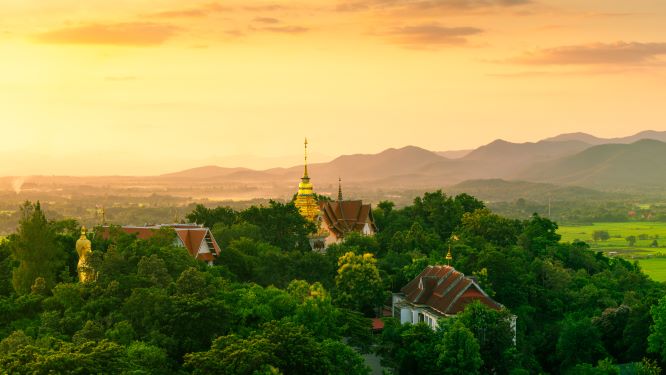
Doi Suthep, Life, Culture, and Spirit of Chiang Mai
Up there over the great mount “Doi Suthep” where one of the most worshipful temples in Chiang Mai “Wat Phra That Doi Suthep” situates. The holy place is recognized as a significant landmark of this historical city that is not just in term of religious, art, and culture, but the site also is a notable tourist destination of Chiang Mai, as well.
That is to say, anyone who comes over at Chiang Mai and do not do to pay homage at Wat Phra that Doi Suthep means you have not been there, yet. Therefore, Wat Phra That Doi Suthep and Doi Suthep itself is an essential tourist resource of this tourist city. And definitely, the place is one of the primary sources of income for the citizen, including to mountaineers and the farmers who live within the terrain for over the decades.
About the Doi Suthep
Doi Suthep or formally called National Park Doi Suthep-Pui is a national park that covers the area of 3 districts – Muaeng, Mae Rim, and Hang Dong district in Chiang Mai province. The space of the national park in entirely is approximately 261 sq.km with the highest peak is “Doi Pui” with 1,685 m above the sea level.
The national park is abundant with forest, even though it is very close to the town. Most of the wood is in the towering mountains with the remarkable peaks are Doi Suthep and Doi Pui. Moreover, the National Park Doi Suthep-Pui is the venue of the significant landmarks which are Wat Phra That Doi Suthep and Bhubing Palace, too.
Background of the Place
After the old capital “Wiang Kum Kam” experienced float regularly, King Mangrai then discovered strategically located a place to build a new town of Chiang Mai in the northwest of the old location. The prospect land was on the plain with the gigantic mountain range in the west and Ra Ming river in the east. The enormous mountain was called as “Doi Oi Chang” (elephant’s sugarcane) which assumed that it might come from the land is rich forest and was the rest area for the elephants.
The forest was high moisture with diverse plants that can be food for the elephants such as sugarcane, wild banana, reed grass, etc. in part, the site is plentiful of water to set up the group of elephants which was the essential factor of the logistics and labor for the city establishment, too.)
Afterward, the citizen of Chiang Mai knows Ra Ming river in the title “Mae Ping” river. On the other hand, it is a myth noted that over the Doi Oi Chang is the location that “Wasuthep” a hermit who settles a city “Lamphun Bampenprot” and Doi Oi Chang later was renamed as “Doi Suthep”. Both Doi Suthep and Mae Ping river are the significant factors led the King Mangrai decided to make the canal and city wall to create Chiang Mai city in 1296, and it has been 722 years of the town and still counting.
Story of Khruba Sri Wichai:
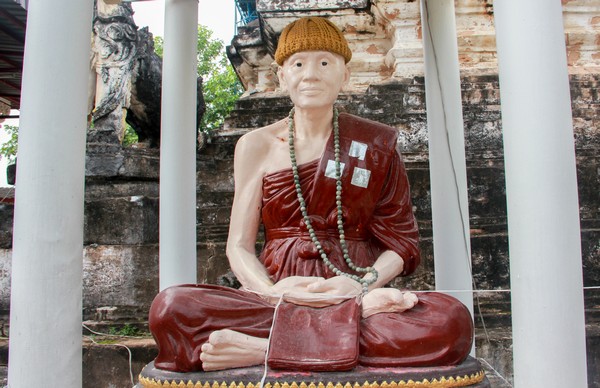
Later, the legendary venerable Buddhist monk of Lanna “Khruba Sri Wichai” assembled the citizen of Chiang Mai to build the road leading to Doi Suthep to facilitate to the citizen in pay the homage at Wat Phra That Doi Suthep in 1934. So-called the most significant incident which projects the unity of Chiang Mai people because the construction is not under any financial and task force support from the government, instead it came from the fundraising and collaboration of the citizen of Chiang Mai, indeed. And the 11 km distance road completed within 5 months and 22 days.
‘Sri Wichai Road’ was officially used dated April 30, 1935, which it is not only to facilitate the residents to travel to Wat Phra That Doi Suthep only but it also the vital route of the tourist attraction in Chiang Mai, too. Moreover, the road is the path to connect the people of Chiang Mai to the natural resource resulted in many acts regarding the environment preservation within the area of Doi Suthep.
Examples include the government gazette, volume 66 in 1949 that proclaimed Doi Suthep Forest as the Forest Protection and volume 81 in 1964 declared the place as the national park according to the National Forest Act, in 1964. And then the government gazette, volume 98 dated April 14, 1981, proclaimed the National Park Doi Suthep to be the National Park Doi Suthep-Pui which the location covered about 161.06 sq.km and expanded to 261.06 sq.km in the year after.
This is the source of water forest and “Lung” of Chiang Mai.
The abundance of Doi Suthep is not beneficial only for the elephant who played the vital role in the city establishment in last 700 years ago. But the place is the source of water site that nurtures the life of Chiang Mai city, too. There is a record noted that there was the wood bench flume that reaches out of Huay Kaew Waterfall and diverse the water into the city.
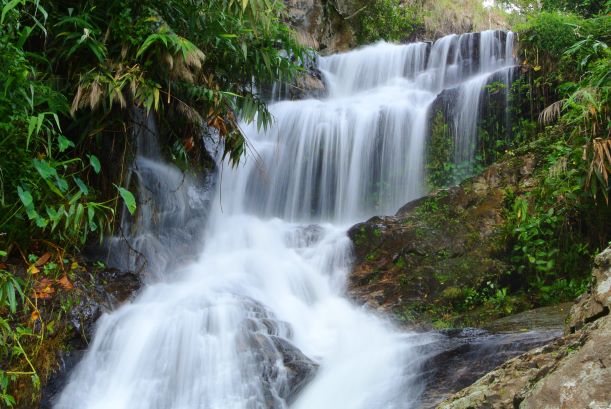
So, it is the pattern of the irrigation system in the ancient time that is so valuable. In the past, the echo of Huay Kaew Fall roared is the voice of humidity and abundance of the city. Apart from that, the National Park Doi Suthep-Pui is not a plentiful forest nearby the town, the place also becomes the relaxing location that everyone can access conveniently, as well.
Plan the trip to Doi Suthep
Since there is plenty of the tourist attractions in Doi Suthep, such as Wat Phra That Doi Suthep, Bhubing Palace, or Doi Pui which are on the same route. However, it is not easy to make the trip to all those places within a day (in-depth site visit would be 2-3 days). So, making a plan for the journey properly is a must for the tourist who wants to visit Doi Suthep because we know that you do not want to miss any of them, do you?
Wat Phra That Doi Suthep
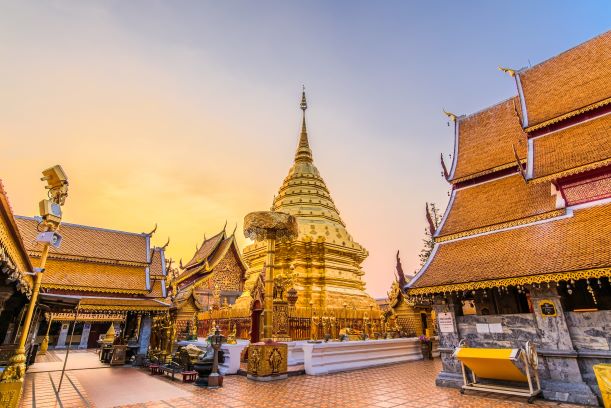
Many say that if you have not yet come to worship at Wat Phra That Doi Suthep means you have not been to Chiang Mai. Definitely, the trip to Doi Suthep is a must not miss visiting this important holy place of Lanna city.
Wat Phra That Doi Suthep or well-known in general “Phra That Doi Suthep” is another notable temple of Chiang Mai. The temple is classified as the royal monastery which was founded since 1386 over the top of Suthep Peak. The compound contains lots of elegant and magnificent Buddhism architecture and sacred object in accordance with the Lanna belief. The main pagoda at the temple is Chiang Saen art which is covered with the gold leaves.
About Wat Phra That Doi Suthep
Moreover, around the great pagoda is the brilliant viewpoint that features the lovely view of Chiang Mai city from the top. To reach the monastery complex, the visitors have to climb up along the hundred’s staircases. Additionally, it believes that Wat Phra That Doi Suthep is the symbolic pagoda for the people who were born in the goat year and based on the local belief one who was born on that year should come to pay homage at the temple for one in the lifetime for prosperity in life.
Since the Buddha’ relics enshrined at the temple, every year during the Visakha Bucha Day (in May) the people from all directions travel to Wat Phra That Doi Suthep to pour the water and pay respect traditionally. In the old days, the pilgrims needed to walk by foot ascending to the peak to present their faith, effort, and diligence. The metaphor the step is the hierarchy of the dhamma practice starts from the beginning stage to the supreme level of arahat (liberated person) which is the destination at Phra That Doi Suthep pagoda.
How to go to Wat Phra That Doi Suthep

To reach the monastery complex are 2 options;
– The naga serpent stairs: As one of the remarkable signature of the place that is delicate, splendid, and valuable in art. The tourist who comes to worship Phra Borom That at Wat Phra That Doi Suthep favors taking the picture at the foot of the stairway for memory. And most of those who come over the place for the first time would walk up and down along the Naga stairs to the temple on the top. The location allows the people to access all day; however there is a checking point set up between 8.00pm – 6.00am.
– The trolley operates every day between 6.00am – 6.00pm with the price for round trip is THB20 per person (for Thai) and THB50 per person (for Foreigners). It is restricted to access to the temple by stairway only after 6.00pm.
Bhubing Rajanives Palace
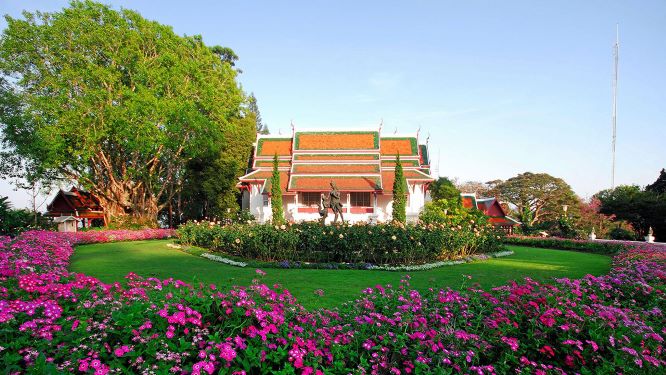
Bhubing Rajanives Palace is a royal winter court for King Rama 9 and the member of the royal family to reside in Chiang Mai during the state duty in the northern territory. And also serves as the guesthouse for the state visitor from abroad.
The compound contains the group of buildings including Bhubing Rajanives Palace, Reun Peek Mai, Reception Building, and Rose Garden. Sirisong Bhubing Villa and the reservoir viewpoint, panorama landscape of the fountain, Pha Mon Pavilion and Fern Garden, Pruksa Visuthikhun Villa, and more. Those structures and landscapes are the beautiful design of architecture which is a must not miss location for the tourist.
Within the royal residence is plenty of different temperature flowers especially rose that is the diversity of species with extraordinary size. The location is the ideal place to relax, leisure, and promenade, indeed. The estimate duration to stroll around the compound is about an hour minimum, but we ensure that it would be worthwhile for you, definitely.
Bhubing Rajanives Palace opens to the public during 8.30am – 4.30pm daily (included any public holidays). However, the place is closed during the royal visit that the visitor can check in prior with the palace office.
Tourist Information:
– The ticket to access Bhubing Rajanives Palace available 2 times which are the morning session (8.30am – 11.30am) and the afternoon session (1.00pm – 3.30pm) and the palace closes at 4.30pm.
– The admission fee is THB20 / person for Thai and THB50 / person for the Foreigners.
– The shuttle transportation is available to service the visitor for the trip around the royal residence area. The price is THB250 / trip with about 4-5 person capacity.
– Occasionally, during January – March the royal palace will be close to the public since it is the place accommodate to the royal family. So, the visitor that would not want to miss the trip and further inquiries, please feel free to visit the website www.bhubingpalace.org
Khru Ba Sri Wichai Monument
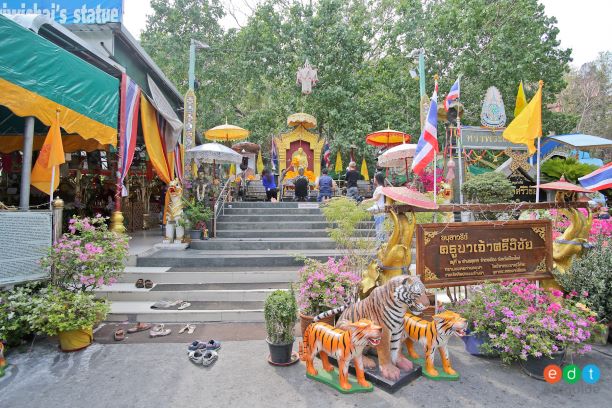
The famous Buddhist monk of Lanna who is the pioneer to make the way to Suthep Peak in 1934. I the past it was so difficult to travel to worship the great pagoda at Wat Phra That Doi Suthep since it was not any proper road as same as in the present. The path was narrow and harsh highway and needed to walk through the forest and ascended the mountain with approximately up to 5 hours to reach the destination. It mentioned in general at that time “Without true faith, and diligence cannot make the worship at Wat Phra That Doi Suthep”.
Khru Ba Sri Wichai, when he resided at Wat Sri Soda started to invite the people of to build the road from the hill to reach the temple at the top of the mountain with about 11 km distance. The way completed in 6 months later and the citizen of Chiang Mai created the monument of the venerable monk of Lanna to commemorate and pay respect abiding.
Not far from the monument is Huay Kaew Waterfall that is another tourist attraction for the tourist who makes the trip to Doi Suthep. The tourist can take a walk in about 300 meters and the opposite side of the Khru ba Sri Wichai Monument is the office of the National Park Doi Suthep-Pui.
San Ku (the ancient remain)
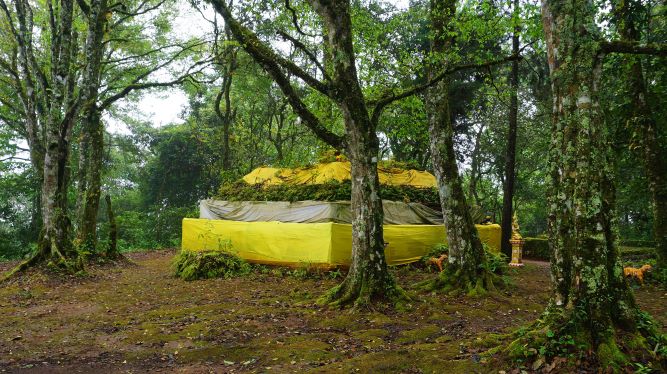
In 1983, the survey team unit 4 of the Department of Fine Art excavated the ancient ruins at San Ku Historical Park. That task is under the assignment of HRH Princess Maha Chakri Sirindhorn after the princess acknowledged that the site was abandoned for ages and it supposes to be inspected and restored by the Department of Fine Art appropriately since then. So, it is graciousness to the study of Thai history and archeology very much.
The condition of the ancient site before the unearthing of the survey team was old dune with dense trees environed the area. The excavation disclosed that there is the ruin of chedi and the base of vihara (sanctuary) and then the team dig in the hole under the pagoda’s base with about 5.30 meters in its depth and discovered items of noticeable antique including head of the Buddha image in Hariphunchai style, Clay Buddha amulets, pieces of ceramic that is assumed to be parts of the small container from China (Ming Dynasty, 1368 – 1644). And other objects from the discovery are pieces of porcelain sourced by San Kam Paeng Kiln. It assumes that San Ku Historical Park is between 19th -22nd Buddhist Century.
How to go to the tourist attractions in Doi Suthep
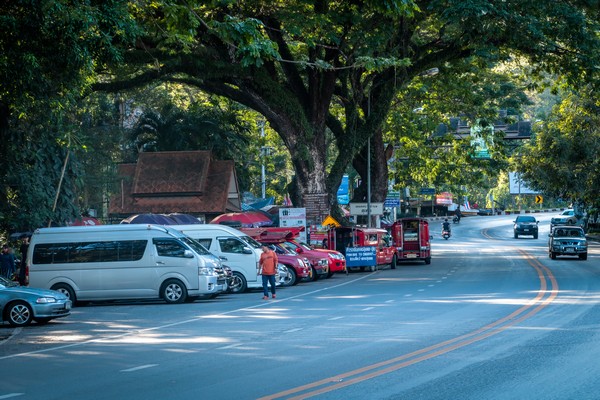
By Car:
The visitor can travel by various vehicles – motorcycle, car, high-performance vehicle.
– From the city of Chiang Mai, you drive om the road Huay Kaew – Chiang Mai University and pass Chiang Mai Zoo and Khru Ba Sri Wichai Monument. From the monument, the path will be steeper with approximately 14 km long. You will pass Huay Kaew Waterfall and arrive at Wat Phra That Doi Suthep. And not far from there, it is an intersection with the signage to enter the national park office is on the right.
– About 4 km from Doi Suthep to Bhubing Rajanives Palace (restrict access for the bus) and further in 4 km to the Hmong Village Doi Pui is a curvy and slope way, so you must drive very carefully. Alternatively, you can park at the palace and get the pick-up truck service to travel to the royal residence, Doi Pui Peak, and Hmong village would be safer.
– To go to San Ku, you can drive on the route Bhubing Rajanives Palace – Doi Pui Peak and pass Hmong Village junction about 3 km more. The road is, but it’s quite narrow. So, you should be careful.
By Public Bus:
From Chang Mai city, you can get the public bus and get off at Chiang Mai Zoo. Then, you get the shuttle bus of Doi Suthep otherwise to hire for the personal group is available, too. The shuttle bus will stop at the tourist attractions along the route of the National Park Doi Suthep-Pui.

